The Machine Glazed Paper Industry Analysis in Korea is estimated to be valued at USD 472.8 million in 2025 and is projected to reach USD 801.1 million by 2035, registering a compound annual growth rate (CAGR) of 5.4% over the forecast period.
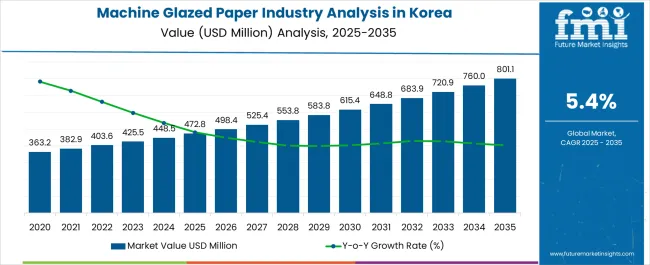
| Metric | Value |
|---|---|
| Machine Glazed Paper Industry Analysis in Korea Estimated Value in (2025 E) | USD 472.8 million |
| Machine Glazed Paper Industry Analysis in Korea Forecast Value in (2035 F) | USD 801.1 million |
| Forecast CAGR (2025 to 2035) | 5.4% |
The machine glazed paper industry in Korea is experiencing stable growth. Increasing demand for high-quality paper products across packaging, hygiene, and industrial applications is driving market expansion. Current trends indicate a preference for lightweight, functional papers that balance strength and printability.
The market is being influenced by advancements in paper manufacturing technologies, improvements in coating and finishing processes, and the adoption of eco-friendly practices to meet regulatory standards. Future growth is expected to be supported by rising consumption in both commercial and domestic segments, expansion of modern retail and e-commerce sectors, and increasing emphasis on sustainable and recyclable materials.
Growth rationale is anchored on the ability of producers to optimize production efficiency, enhance product quality, and meet evolving consumer and industrial requirements Continuous investment in research and development, coupled with strategic supply chain management, is expected to sustain competitive positioning and facilitate long-term market expansion.
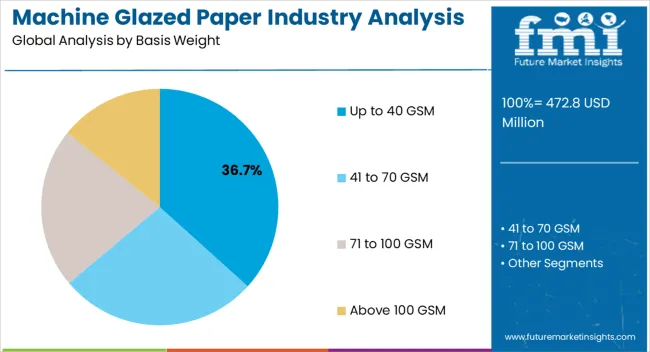
The up to 40 GSM segment, accounting for 36.70% of the basis weight category, has maintained market leadership due to its suitability for lightweight applications that require cost efficiency and flexibility. Its adoption has been driven by increasing demand for thin yet durable papers in packaging and hygiene products.
Production processes have been optimized to ensure uniformity, strength, and surface smoothness, while quality standards have been reinforced to meet both domestic and international regulatory requirements. Technological advancements in refining, calendaring, and coating have enhanced paper performance, and strategic procurement of raw materials has ensured consistent supply.
The segment’s dominance is expected to continue, supported by innovation in functional properties and ongoing preference for lightweight papers in cost-sensitive applications.
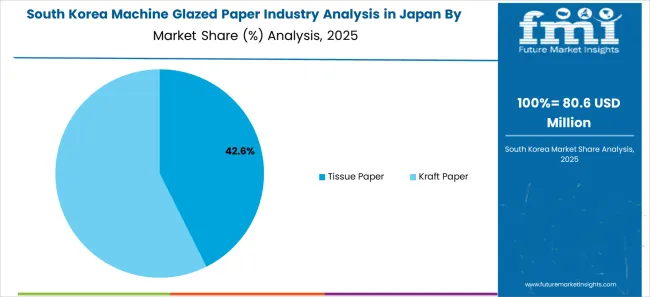
The tissue paper segment, representing 42.10% of the paper type category, has emerged as the leading type due to its widespread usage in hygiene, personal care, and hospitality sectors. Adoption has been reinforced by increasing consumer awareness of hygiene standards and growing demand for premium and soft tissue products.
Manufacturing improvements, including advanced creping, embossing, and ply integration, have enhanced product quality and usability. Supply chain efficiency, regulatory compliance, and product certification have strengthened market acceptance.
Continued growth is expected as consumer preference for convenience and quality drives tissue paper adoption, ensuring the segment maintains its leading share in the paper type category.
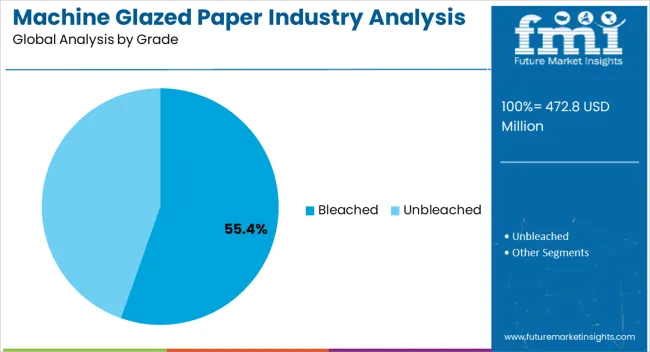
The bleached segment, holding 55.40% of the grade category, has led the market due to its superior whiteness, brightness, and functional versatility. Its adoption has been supported by applications requiring high-quality printability, hygiene standards, and aesthetic appeal.
Production techniques such as chemical bleaching, fiber optimization, and finishing processes have ensured consistent product performance and compliance with environmental regulations. Market acceptance has been reinforced by increasing demand for premium paper products and industrial usage in packaging and hygiene applications.
Continued focus on quality enhancement, cost-efficient production, and sustainability initiatives is expected to sustain the segment’s leading position and contribute significantly to overall market growth.
The enduring dominance of kraft paper, projected to maintain an 80.00% industry share until 2025, stems from its versatility and reliability in packaging applications. Renowned for its strength, durability, and eco friendly attributes, kraft paper remains a preferred choice across diverse sectors.
| Paper Type | Kraft Paper |
|---|---|
| Industry Share | 80.00% |
Adaptability to various printing and coating techniques further solidifies kraft paper’s position. The rising demand for sustainable packaging solutions aligns perfectly with its eco conscious nature, ensuring its continued prominence as the go to material for a multitude of packaging needs within Korea machine glazed paper industry.
The projected dominance of unbleached paper, maintaining a 66.90% industry share until 2025, stems from its eco friendly nature and minimal processing. Renowned for its natural appearance, unbleached paper retains its natural brown hue, appealing to environmentally conscious consumers.
| Grade | Unbleached Paper |
|---|---|
| Industry Share | 66.90% |
Its popularity is due to the reduced environmental impact during production, aligning with sustainable packaging trends. The inherent strength and versatility of unbleached paper further reinforce its position, catering to diverse packaging needs. With an increasing emphasis on eco conscious practices, unbleached paper remains a steadfast choice, driving its continued dominance in Korea machine glazed paper industry.
In South Jeolla machine glazed paper industry, innovative trends redefine the landscape. Advanced manufacturing technologies drive a shift towards eco friendly practices, emphasizing sustainability and recyclability. Adoption of renewable energy sources and efficient production processes showcases its commitment to environmental responsibility.
The industry witnesses a trend towards customization, catering to diverse packaging needs across sectors. Manufacturers focus on creating tailored solutions, offering varied paper grades, sizes, and coatings, meeting specific client demands and enhancing product versatility.
Integration of smart technologies like IoT and automation streamlines production, optimizing efficiency and reducing operational costs. These advancements bolster the position of South Jeolla in the industry, ensuring high quality, cost effective machine glazed papers.
Exploration of alternative raw materials, continuous research, and development efforts drive innovation, fostering product improvements and novel applications. South Jeolla machine glazed paper industry stands at the forefront of technological innovations, sustainability, and customization, shaping the future of packaging solutions.
North Jeolla machine glazed paper industry is witnessing a surge in opportunities due to various factors. Its rich forestry resources and advanced paper manufacturing infrastructure position it favorably in the industry. The industry benefits from a skilled workforce and robust research and development capabilities, fostering innovation in paper production techniques and product diversification.
Increasing demand for sustainable packaging solutions globally present a significant growth avenue for North Jeolla machine glazed paper sector. Its emphasis on eco friendly practices aligns with evolving consumer preferences and regulatory shifts toward environmentally responsible packaging materials.
Strategic partnerships and collaborations between local manufacturers and international industries amplify presence of North Jeolla in the global paper industry. Leveraging these strengths, the region capitalizes on emerging industry trends, technological advancements, and sustainable practices, paving the way for continued growth and prominence in the machine glazed paper sector.
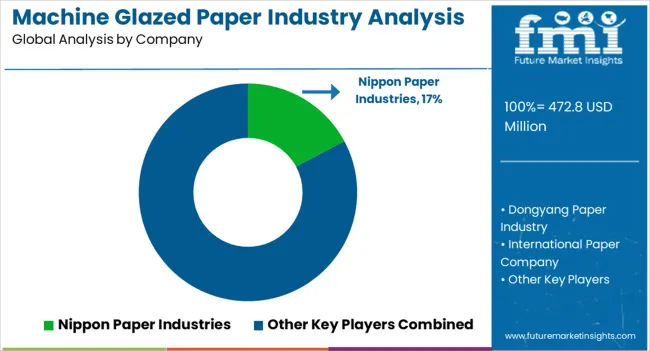
The competitive landscape within Korea machine glazed paper industry is characterized by a blend of established players and emerging manufacturers striving for industry prominence. Key companies leverage technological advancements to produce high quality, eco friendly papers, meeting diverse packaging demands.
Continuous innovation in manufacturing processes and a focus on sustainable solutions define the competitive edge. Intense competition fosters advancements in product quality, cost efficiency, and customization.
Strategic collaborations and expansions into new industry segments reflect the dynamism, shaping a competitive arena where innovation, sustainability, and meeting specific customer needs are pivotal for success in Korea machine glazed paper industry.
Product Portfolio
| Attribute | Details |
|---|---|
| Estimated Industry Size in 2025 | USD 472.8 million |
| Projected Industry Size in 2035 | USD 801.1 million |
| Attributed CAGR between 2025 and 2035 | 5.4% CAGR |
| Historical Analysis of Demand for Machine Glazed Paper in Korea Regions | 2020 to 2025 |
| Forecast Period | 2025 to 2035 |
| Report Coverage | Industry size, industry trends, analysis of key factors influencing Machine Glazed Paper in Korea, insights on global players and their industry strategy in Korea, ecosystem analysis of local and regional Korea providers. |
| Key Regions within Korea Analyzed while Studying Opportunities for Machine Glazed Paper in Korea | South Gyeongsang; North Jeolla; South Jeolla; Jeju; Rest of Korea |
| Key Companies Profiled | Dongyang Paper Industry; International Paper Company; Nippon Paper Industries; Stora Enso; Smurfit Kappa Group; Mondi Group; Heinzel Group; Burgo Group; SCG Packaging; Verso Corporation |
The global machine glazed paper industry analysis in Korea is estimated to be valued at USD 472.8 million in 2025.
The market size for the machine glazed paper industry analysis in Korea is projected to reach USD 803.5 million by 2035.
The machine glazed paper industry analysis in Korea is expected to grow at a 5.4% CAGR between 2025 and 2035.
The key product types in machine glazed paper industry analysis in Korea are up to 40 gsm, 41 to 70 gsm, 71 to 100 gsm and above 100 gsm.
In terms of paper type, tissue paper segment to command 42.1% share in the machine glazed paper industry analysis in Korea in 2025.






Full Research Suite comprises of:
Market outlook & trends analysis
Interviews & case studies
Strategic recommendations
Vendor profiles & capabilities analysis
5-year forecasts
8 regions and 60+ country-level data splits
Market segment data splits
12 months of continuous data updates
DELIVERED AS:
PDF EXCEL ONLINE
Machine Condition Monitoring Market Size and Share Forecast Outlook 2025 to 2035
Machine Vision Camera Market Size and Share Forecast Outlook 2025 to 2035
Machine Tool Oils Market Size and Share Forecast Outlook 2025 to 2035
Machine Vision System And Services Market Size and Share Forecast Outlook 2025 to 2035
Machine Tool Cooling System Market Analysis - Size, Share, and Forecast Outlook 2025 to 2035
Machine Tool Touch Probe Market Analysis - Size, Growth, and Forecast 2025 to 2035
Machine Mount Market Analysis - Size & Industry Trends 2025 to 2035
Machine Control System Market Growth – Trends & Forecast 2025 to 2035
Machine Automation Controller Market Growth – Trends & Forecast 2025 to 2035
Machine-to-Machine (M2M) Connections Market – IoT & Smart Devices 2025 to 2035
Machine Safety Market Analysis by Component, Industry, and Region Through 2035
Machine Vision Market Insights – Growth & Forecast 2024-2034
Machine Learning As A Services Market
Machine Glazed Paper Market Size and Share Forecast Outlook 2025 to 2035
Key Players & Market Share in Machine Glazed Paper Industry
Machine Glazed Paper Industry Analysis in Asia Pacific Forecast Outlook 2025 to 2035
Machine Glazed Paper Industry Analysis in Western Europe Size and Share Forecast Outlook 2025 to 2035
Machine Glazed Paper Industry Analysis in Japan Size and Share Forecast Outlook 2025 to 2035
Machine Glazed Kraft Paper Market Forecast and Outlook 2025 to 2035
BMI Machine Market Size and Share Forecast Outlook 2025 to 2035

Thank you!
You will receive an email from our Business Development Manager. Please be sure to check your SPAM/JUNK folder too.
Chat With
MaRIA